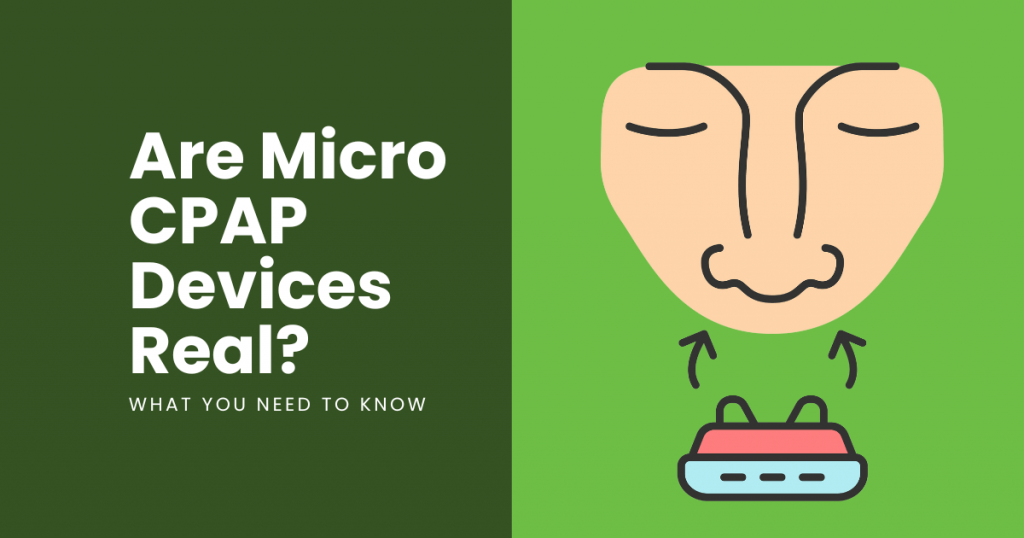
Here’s the reality today: a “micro CPAP” that does not use a motor, hose, and mask doesn’t really exist (yet), at least not one that is approved for the treatment of Obstructive Sleep Apnea (OSA).
In decades past, CPAP machines were large bulky units that were noisy, and you’d never think about taking one on the go with you. Today, with advancements in CPAP therapy technologies, many manufacturers offer small, quiet, ultra-portable devices that allow you to travel and bring your therapy on the go.
With that being said, the reason we wrote this article is to clear up the confusion online surrounding what some are considering micro CPAP machines. One example is the Airing Micro CPAP, which has gained a bit of notoriety, despite not being FDA-approved for sleep apnea.
Hopefully, by the time you finish reading this article, you’ll know what is real and what is not. Plus, we’ll briefly share with you real CPAP machines that are small and compact if that’s what you are in the market for when searching for a true “micro” CPAP device.
Claims Surrounding Micro CPAP Devices
Devices like the Airing Micro CPAP are being promoted as a direct alternative to Continuous Positive Airway Pressure therapy. The idea behind this device is that it’s less invasive and more comfortable than standard machines. One of the most notable differences between micro and regular CPAP machines is that micro CPAP machines are advertised as not requiring a mask or hose, making them a more lightweight, unobtrusive option.
These claims include reduced noise, fewer sleep disruptions, and decreased snoring. However, it’s important to note that micro-CPAP devices, including the Airing device, are still undergoing FDA approval and lack clinical evidence to support their effectiveness. It’s recommended to follow a doctor’s treatment plan and consider lifestyle changes alongside any sleep apnea treatment, always.
But don’t just take our word for it; watch this video from a sleep surgeon who explains it quite well:
While your typical CPAP machine is a bedside device that requires a motor about the size of a softball, the micro option is advertised as the total opposite. According to the limited information we could find, instead, they are made up of a very small, bean-shaped device that sits right under your nose and is held in place via a nose bud-style attachment. It is important to remember that while these products may seem great on paper, a working version of this tech has not yet been approved by the FDA.
Manufacturers claim that these miniature machines address many of the chief complaints of individuals who sleep with a standard CPAP each night. These include:
- Noise Reduction: Regular CPAPs do produce some noise, either from the machine itself or the sound of the air flowing through the tubing and mask.
- Increased Comfort: Manufacturers claim that these devices are much more comfortable, as they do not require a mask or bulky hoses.
- Eliminates Snoring: Like a standard CPAP, micro versions seek to reduce the number of airway blockages that can cause sleep apnea and/or snoring.
- Cost Effective: There is no denying that the versions of this product that are currently on the market are substantially cheaper than a CPAP. We’re talking $30 compared to $2,000. Of course, these products are largely pressurized air machines in name only. And although future devices may eventually work, to a degree, they will likely be sold at much higher prices as well.
- Compact Size: As anyone familiar with CPAP can tell you, they can be quite bulky. It can be inconvenient trying to find a place to store your CPAP, especially when traveling. Having a smaller option that can practically go anywhere is a big advantage of smaller CPAP machines, including micro ones.
It’s also important to note that the lack of clinical evidence is a significant drawback when it comes to micro CPAP machines for sleep apnea. Without proper clinical testing, it’s challenging to establish the effectiveness of these devices when compared to traditional CPAP machines. Clinical trials and research studies are necessary to determine the safety and efficacy of these devices as a legitimate treatment option for sleep apnea.
Understanding Micro CPAP Technology
So, how does micro CPAP work? Well, that’s a bit of a difficult question to answer. To start, it’s important to note that there are two different versions of these machines. One is in the early stages of development, while the other is just simply ineffective.
New Technology Is Still in Development
Before we go into the details of how this works, it’s important to remember that the most “promising” option is still very early on in the development process. That said, the basic idea is that instead of using one large motor to create a flow of pressurized air, the micro-device would rely on hundreds of tiny fans called “micro-blowers”. In theory, these fans would be activated when air is drawn into the device through an inhalation vent, producing a stream of pressurized air that then travels through the nasal passage and into the upper airway.
While this sounds exciting, the problem with this technology is that it simply does not exist in a way that can be harnessed to act as a miniature CPAP machine. In fact, as of today, there are no functioning prototypes that use this specific tech. To state it plainly, a functioning version of this machine does not exist at this moment in time.
Existing Technology Leaves a Lot to Be Desired
You may be wondering, “If this technology doesn’t actually exist yet, then why are there so many micro CPAPs available to buy online right now?” This is where existing technology comes into play— if you can even call it that. Although advertised as a CPAP alternative, these devices fail to produce any significant pressure at all, let alone enough to hold your airway open. Ultimately, they do nothing to treat sleep apnea and are not worth your money.
Recently, one well-respected reviewer on YouTube decided to examine one of these devices on camera. What he found were two small fans, which created what we would consider to be a slight breeze at best. Like the other Micro CPAP devices, this particular product could not possibly produce enough pressurized air to actually qualify as a CPAP machine of any kind, micro or otherwise.
Watch for yourself:
What to Know Before Buying a Micro CPAP Device
This type of CPAP alternative is sold by a few different manufacturers, but thus far, none have offered any real substantial evidence that they are effective for OSA or CSA treatment. Nor have any received FDA approval. So to be clear, the most important thing to know about buying a micro CPAP machine is that you shouldn’t.
Unless, of course, you’re referring to the Transcend Micro Auto Travel CPAP, which is FDA-approved for treating sleep apnea. This device has the word “micro” in it, and for good reason: this is why we listed it as our #1 smallest CPAP available on the market.
Regarding the influx of micro CPAP machines for sale online, many experts in the sleep apnea community have concerns that many of the businesses promoting micro CPAP machines are prioritizing product sales over helping people with sleep apnea. The most prominent micro CPAP company, Airing, has even been accused of offering pre-sales for a product that utilizes a type of technology that does not actually exist yet. And while some other manufacturers do have actual devices for sale, those machines do not function as advertised.
Other Micro CPAP Devices
While Airing devices have not yet made it to market, there are some other “micro CPAP” products that are currently available on several online retailer sites, including Amazon. When researching such devices you may note that some of them have high Amazon ratings. However, when you look into the reviews themselves, they aren’t actually for the product being advertised. If you are considering purchasing one of these devices, it is important that you understand that they will not be able to replace your CPAP or any other sleep apnea therapies.
Why CPAP Is a More Effective Sleep Apnea Treatment
Beyond the issues that we have discussed above, there are a few reasons why we highly suggest skipping these new devices and opting for proven and FDA-approved therapy devices:
For one, CPAPs have been proven time and time again to be a highly effective first line of treatment for any type of sleep-disordered breathing.
But let’s say, for a moment, that the technology needed to produce a fully functional miniature CPAP did exist today, and that micro CPAP machines could be used to treat sleep apnea. Assuming that was all true, we would still suggest going with a standard CPAP machine.
Here are some reasons why:
- Pressure Settings: The amount of air pressure created by the CPAP is supposed to be individualized. When you first get your machine, a specialist calculates the appropriate pressure setting for you and adjusts it accordingly. It then stays on that setting unless you bring it back to the specialist to be changed. On the other hand, current micro CPAP machines do not offer pressure settings that can be adjusted. Or if they do, it’s simply the difference between a ‘low’ and ‘high’ setting, and certainly can’t be calibrated to your exact pressure needs.
- Humidity Control: One of the more common complaints from people who sleep with CPAP machines is that the air can really dry out your mouth and/or nose. Regular CPAP machines offer climate control options, with many modern options including a built-in humidifier to cut down on how dry the air is. Micro-devices are too small to offer such features.
- Device Lifespan: Whether you are going with the Airing option (if it ever becomes available) or are looking to purchase a micro CPAP from another manufacturer, it is pretty safe to assume that the lifespan will not be able to compete with that of a regular CPAP machine. In fact, the Airing company currently claims that their device would be single-use, meaning it would need to be replaced on a daily basis.
If you are someone who has benefited greatly from CPAP or is just starting sleep apnea therapy but is turned off by the size and complexity of the standard machine, we have some good news! While the technology for hoseless, motorless CPAP machines is not yet available, the market does have a handful of travel-sized CPAP machines which are FDA-approved for treating sleep apnea. One of our favorites is the Somnetics Transcend Micro CPAP Machine, which you can read about here!
Related reading: Looking for the best CPAP machine? We’ve got you covered! Read our review of the latest CPAP machines to find your perfect match!
Alternative Solutions for Sleep Apnea
Despite its popularity, we know that CPAP isn’t always a good fit for everyone. Some people seem to struggle with it more than others. If you fall into that category, we want you to know that there are other treatments out there. If you are interested in alternative solutions, we encourage you to speak to your doctor.
Here are some other solutions for sleep apnea:
- Other Positive Airway Pressure (PAP) Devices: Some people who sleep with a CPAP machine find that they really struggle to exhale against the flow of pressurized air. In such situations, you may simply need a Bi-Level Positive Airway Pressure (BiPAP) machine, which produces a higher level of pressurized air during inhalation and a lower one during exhalation. Another alternative is an Automatic Positive Airway Pressure (APAP) machine. This device measures your breathing patterns as you sleep and adjusts the level of air pressure accordingly, based on your immediate needs.
- Oral Appliance Therapy (OAT): If you are someone who has Obstructive Sleep Apnea and has seriously considered switching to a micro CPAP, this may be a good alternative for you. Oral devices work by positioning the jaw and mouth so that the tongue, soft palate, and other muscles are less likely to collapse into the airway. They are motorless and hoseless, meaning they do not make extra noise and may be more comfortable for some people, though they’re typically only prescribed for those with mild to moderate OSA.
- Surgery: While this is not necessarily a super common solution, some cases of sleep apnea are due to a structural issue that can be fixed via surgery. Some examples are enlarged tonsils and adenoids or a deviated septum.
- Positional Sleeping: Sleeping on your side may reduce your risk of airway obstruction and, therefore, can decrease the number of breathing issues you experience as you sleep. For more information on the best sleeping positions for people with sleep apnea, check out our comprehensive guide!
- Lifestyle Changes: Sleep apnea often arises due to certain lifestyle choices, such as drinking alcohol or taking certain medications or substances. If you are living with sleep apnea, your doctor either has or likely will suggest making some changes, such as diet and exercise and avoiding triggers like cigarette smoking.
- Treating Underlying Conditions: Some cases of sleep apnea may be triggered by an underlying condition. For example, Central Sleep Apnea can be caused by neurological conditions or brain tumors. And gastroesophageal reflux disease and neuromuscular diseases can contribute to Obstructive Sleep Apnea. In such situations, it is important that you address any contributing factors which may have caused you to develop sleep apnea.
Frequently Asked Questions
Here are some common questions about micro CPAP devices!
Are Micro CPAPs FDA Approved?
As of 2024, the FDA has not approved any micro CPAP devices. The products that are currently available for purchase are not recommended for the treatment of any type of sleep apnea. While some manufacturers promise that their device reduces snoring or improves airflow, none of these claims have been validated.
What is a Micro CPAP Machine?
A micro CPAP machine is a small device that is supposed to act as an alternative to the standard CPAP machine. The miniature device fits right under your nose and is held in place using nose buds instead of a full mask.
In theory, once turned on, these devices would deliver pressurized air through the nasal passages and into the airway. It is important to know that this technology is not actually available yet, so this description should be considered a hypothetical one; the products that are currently available are incapable of creating a flow of pressurized air and are inadequate for treating obstructive sleep apnea.
Does Micro CPAP Work for Mouth Breathers?
At this point in time, there are no micro CPAP products that are compatible with mouth breathing. This is unlikely to change, as the idea behind these products is that they do not require a mouthpiece or face mask at all.
Is There an Alternative to a CPAP Machine?
There are a few alternatives to CPAP machines! The best option for you really should depend on your specific needs and is best discussed with your healthcare provider. If you are struggling to breathe out against the flow of pressurized air but still need some respiratory support, a BiPAP may be a better solution for you. On the other hand, if you are struggling due to the side effects of CPAP and you want a non-mechanical option, oral appliance therapy may be better for you. And in some circumstances, your doctor may suggest surgery to address your sleep apnea.
Is There a CPAP Machine That Doesn’t Require a Mask?
Technically the answer is no, all CPAPs require you to wear a mask of some sort. This is because a mask is the only way to ensure that the air from the machine is delivered into the airway. That said, there are different types of masks, and not all of them require you to fully cover your nose and mouth. Some sit in the nose, similar to what is described with the micro CPAP device but with hoses and tubing. If you’re interested in learning about your ideal mask type, try our free CPAP mask finder tool!
Conclusion
If you are struggling to stay consistent with your CPAP machine and are looking for an alternative solution, you may have come across a product called the micro CPAP. While manufacturers talk up these interesting devices, it’s important to note that the current technology just isn’t advanced enough to pack the power of a full-sized machine into a tiny, bean-shaped device that fits just under your nose.
The bottom line is that there are no FDA-approved micro CPAP machines on the market today. And so far, it seems that the technology needed to create such a product could be decades away. That said, if you are seriously considering discontinuing your CPAP therapy and are in need of an alternative, there are other options! Start by talking to your doctor about other Positive Airway Pressure machines or perhaps Oral Appliance Therapy. Depending on what your doctor says, you may even benefit from a sleep apnea mouthguard.
Whatever you decide to do, be sure to discuss the changes you want to make with your healthcare provider. They can ensure that your treatment plan continues to support your overall health and wellness goals while also meeting any specific needs you may have.



